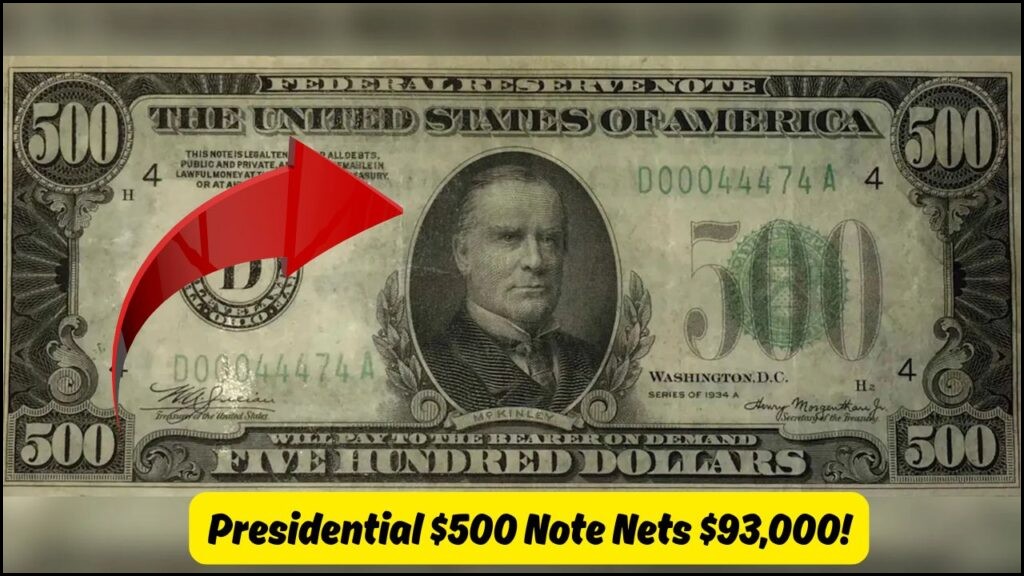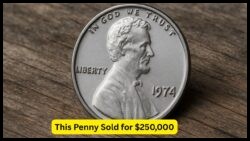$500 Bill – The world of rare currency collecting has once again sparked major interest after a vintage $500 bill featuring President William McKinley’s face was recently sold for a staggering $93,000 at auction. Yes, you read that right — a single piece of paper currency, once used for standard high-value transactions, now holds nearly 186 times its original worth! This stunning sale has collectors and everyday citizens across the country rummaging through old drawers, safe boxes, and inherited collections in hopes of finding similar treasures. The bill, known as a “Federal Reserve Note” issued before the 1940s, carries historical, aesthetic, and collector value — especially when preserved in good condition. So what exactly makes the McKinley $500 bill so valuable, and do you have one hiding in your home? Let’s explore the history, valuation, features, and how you can check if you’re sitting on a small fortune.
Why the $500 McKinley Bill is So Valuable
The McKinley $500 bill isn’t just valuable because of its high face value. It is a rare collector’s item with limited availability and massive historical appeal.
- Only issued for high-denomination transactions between banks before electronic systems were common.
- Discontinued officially in 1969 by the U.S. Treasury.
- Collectors seek bills in pristine or near-pristine condition.
- Bills with specific serial numbers, errors, or signatures fetch even higher prices.
- Older bills issued in the 1920s and 1930s have more collector value.
Key Details of the $500 McKinley Note
Below is a summary of the most critical features and pricing information that affect the bill’s resale value today.
| Feature | Details |
|---|---|
| President on Note | William McKinley |
| Original Denomination | $500 |
| Years Issued | 1928, 1934 (most common), and 1934A |
| Discontinued | July 14, 1969 |
| Material | Cotton & linen paper |
| Current Auction Price Range | $5,000 – $120,000+ (based on condition & rarity) |
| Bill Type | Federal Reserve Note (not a Silver Certificate) |
| Most Valuable Serial Numbers | Low (00000001–00000100), star notes, and misprints |
What Increases the Bill’s Value?
Not all $500 McKinley bills are equal. Some are worth much more than others depending on various unique traits.
Factors That Boost Value:
- Condition: Crisp Uncirculated (CU) or About Uncirculated (AU) bills sell for the highest prices.
- Serial Numbers: Unique or low serial numbers increase the rarity.
- Star Notes: These are replacement notes marked with a star and are extremely collectible.
- Bank of Issue: Bills issued from lesser-known Federal Reserve Banks (e.g., Minneapolis) can be more valuable.
- Signatures: Earlier signature combinations are rarer than later ones.
- Printing Errors: Misprints, off-center inks, or duplicate serial numbers can drive up price significantly.
How to Identify an Original McKinley $500 Bill
If you suspect you may have one of these bills, look for the following features carefully:
Authentication Checklist:
- President William McKinley’s face centered on the front.
- Serial number printed twice — top right and bottom left.
- “Federal Reserve Note” clearly marked.
- Series year of 1928 or 1934 (printed near the bottom right corner).
- Large “500” printed in the corners.
- High-quality paper feel (cotton/linen blend with red and blue security fibers).
- Seal of issuing Federal Reserve Bank present.
Tip: Be wary of reproductions or novelty items often sold online or at tourist shops.
Recent High-Value Auctions
The $93,000 sale isn’t an isolated case. Here’s a look at recent public sales of the McKinley $500 bill.
| Year | Condition | Features | Auction Price |
|---|---|---|---|
| 2023 | Crisp Uncirculated | Star Note, Rare Serial | $93,000 |
| 2022 | About Uncirculated | Serial 00000025 | $76,500 |
| 2021 | Fine Condition | Standard Note, Atlanta Fed | $12,800 |
| 2021 | Extremely Fine | Minneapolis Fed, Error Note | $41,300 |
| 2020 | Very Fine | Chicago Fed, Common Serial | $7,200 |
| 2019 | Uncirculated | Star Note, New York Issue | $65,000 |
| 2018 | Circulated | Stained & Torn Bill | $2,500 |
What to Do if You Find One
You may be one of the lucky few who inherited or discovered this rare note. But don’t rush to sell it without understanding its worth.
Immediate Steps:
- Do NOT attempt to clean or laminate the bill.
- Store in a dry, flat, non-stick holder.
- Contact a certified currency grader (like PMG or PCGS).
- Get multiple quotes from trusted currency dealers.
- Consider listing at top-tier auction houses (e.g., Heritage Auctions).
Are High-Denomination Bills Still Legal Tender?
Yes, technically they are still legal tender. However, their collector value far outweighs face value.
Legal & Circulation Facts:
- The U.S. Treasury stopped issuing bills over $100 in 1969.
- Still redeemable at face value — but doing so is financially foolish.
- Cannot be withdrawn from banks or ATMs today.
- Still recognized by collectors, museums, and major auction platforms.
The discovery and sale of a McKinley $500 bill for $93,000 has reignited public excitement and treasure-hunting fervor across the U.S. These notes, once used for institutional transactions, are now prized historic relics. If you’ve inherited any old bills or kept antique currency as memorabilia, now is the time to pull them out and take a closer look — it could quite literally pay off. Even if you don’t find a $500 bill, understanding what makes rare currency valuable can help you assess the worth of other old notes or coins. With rising interest in collectibles and historic artifacts, the value of such bills is only expected to increase in the coming years.
FAQs of $500 Bill
Q1. Is it legal to sell the $500 McKinley bill?
Yes, it is 100% legal to sell or auction high-denomination notes like this one.
Q2. Can I cash in the bill at a bank?
Technically yes, but it would only be worth $500 — a huge loss compared to collector value.
Q3. Where can I get my $500 bill appraised?
You can approach professional services like PMG (Paper Money Guaranty) or reputable auction houses.
Q4. What if my bill is torn or damaged?
Even damaged bills can have value, but condition heavily impacts price. Get it graded before selling.
Q5. Are other high-denomination bills also valuable?
Yes, $1,000, $5,000, and $10,000 bills are even rarer and can sell for $100,000+ depending on condition.






